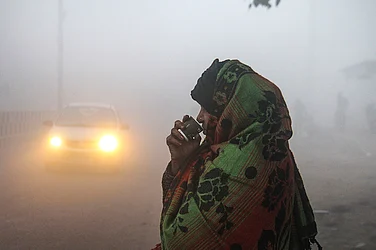Kerala witnessed the second outbreak of Nipah Virus (NiV) this year with a 24-year-old student in Malappuram succumbing to it on September 16, 2024. 267 people were traced as the victim's contacts, out of which 134 were included in the high-risk category. However, no other case has been detected so far as all the samples tested negative. As usual, rigorous contract tracing, surveillance and case isolations were done and a lockdown (at the local level) was imposed. The restrictions have now been relaxed and people in two adjacent panchayats are getting back to their normal lives.
This is the second death in four months due to the Nipah virus. A 14-year-school boy from Vandoor in Malappuram succumbed to the virus in July at the Kozhikode Medical College. Rigorous contract tracing, quarantining and isolation of suspected cases were strictly followed and no additional cases were detected.
Nipah outbreak has become an annual health hazard in Kerala. The latest one is the sixth since 2018, when the presence of NiV was first recorded. It claimed 17 lives at that time. The close observation of the annual occurrence has brought a few factors to light. Studies show that Kerala has so far recorded 28 per cent sero prevalence among bats, which is probably the highest globally, based on findings available in the public domain. There is a strong seasonal pattern as well. So far the outbreak has happened between May and September, which coincides with the bat breeding season and Kerala’s fruit season. Since the initial outbreak in Kerala in 2018, Nipah virus has infected 29 individuals, resulting in 22 fatalities. Notably, all cases have occurred within this timeframe between May and September.
The Indian flying foxes or P. Medius bats in the family of fruit bats have been identified as the reservoir of the virus in Kerala. Research conducted in the affected areas has categorically proved sero prevalence (presence of anti-bodies that indicate the bats have been exposed to the virus) in this species of bats in Kerala. The sero positivity rate (among bats) was recorded as 9 per cent in February and 24 per cent in July in 2023. This goes higher in September, when 28 per cent sero positivity was documented. “This is probably the highest, I presume” says Dr T S Anish, the Nodal Officer of Kerala One Health Centre for Nipah Research. He says that so far no higher sero positivity has been recorded anywhere else in the world to the best of his understanding. According to experts, the research on Nipah, which has been termed a potential pandemic by WHO, is at an infant phase in India. There is very little that the country knows about this dangerous zoonotic disease that is probably a direct result of ecological imbalances and climate change.
The root of infection is yet to be established
Kerala is yet to resolve the mystery of the origins of the human infection. The fruit bats found in plenty in the Western Ghats are the natural reservoir for the virus, but the root of transmission of the virus to humans remains a hypothesis. It has been assumed that the primary cases might have consumed fruits or palm sap contaminated with NiV, which is present in the urine or saliva of fruit bats. So far, this is only a theory unsupported by evidence. Though bat positivity is consistently traced every year ahead of the outbreak, no intermediary hosts for the virus have been found so dar. In other South Asian countries, the role of intermediaries have been established. The first ever reported outbreak in South Asia that occurred in Malaysia in 1999 and claimed 106, spread from a pig farm. Both animal-to-human and human-to-human transmission has been documented. On the other hand, in the outbreaks in Kerala, while human-to-human transmission has been established, the root of the transmission to the primary case remains unproved. According to Vinod A Narayanan, assistant professor at the department of Biochemistry at Ramachandra Medical College and Research Institute Chennai, the direct transfer of bat viruses to humans is a rare event.
The epidemicity of Nipah virus (NiV) varies across nations, as exemplified by the Malaysian outbreak. In this incident, pigs likely contracted the virus by consuming fruit contaminated with bat saliva, leading to extensive viral spread within pig farms. Notably, unlike later outbreaks such as in Kerala, Malaysia's incident showed no evidence of human-to-human transmission. The transmission pattern could be different in different ecological contexts. According to researchers, so far very little is known about India's pattern of transmission, seasonality, the bat behaviour, the ecological reasons and the role of human-animal conflict in this potential pandemic which has so far recorded a 97 per cent fatality rate.
An environmental issue rather than a medical issue
In a paper carried by International Journal of Community Medicine and Public Health, Dr Vinod A Narayan argues that the loss of natural habitats of bats is a significant factor for the emergence of bat-related viral infections communicable to humans and animals. "As the flying fox habitat is destroyed by human activity, the bats get stressed and hungry, their immune system gets weaker, their virus load goes up, and a lot of virus spills out in their urine and saliva," he argues.
Fruit bats are essential for tree pollination and seed distribution. A study on fruit bat feeding patterns found that just three common fruit bat species contribute to the pollination and seed distribution of over 114 different plant types. India is home to more than 90% of the total bat diversity of South Asia. They are also key predators of night-flying insects.
A study on flying fox bats found that there is currently a sharp drop in the number of the species to nearly half. "Flying fox colonies used to be enormous, typically numbering in the thousands; now a days, the average size is 500 or less. Tree cutting and other human annoyances posed a threat to more than 70 per cent of the species," argues Dr Vinod Narayan. The largest flying foxes roost in vast colonies in trees and are consequently susceptible to annihilation by human interventions, according to him.
Hundreds of Indian flying foxes perished in May 2024 as a result of severe heat waves in northern India, mostly in Rajasthan. According to reports, temperatures above 45°C caused mass mortality, with 400 bats dying in one event and 300 in another. Other states including Jharkhand, Delhi, Uttar Pradesh, and Madhya Pradesh also reported bat fatalities.
India has learned the importance of preserving bats only recently. As they prey on fruit-bearing trees, Indian flying foxes were classified as vermin under Schedule V of the Wildlife Protection Act, 1972, till 2022. The mass culling is allowed if an animal is included in the list of vermins. In a 2022 amendment to the Act, Indian flying foxes were transferred from Schedule V to Schedule II, which carries harsh penalties for killing species on its watch list.
Only in Kerala? Certainly not.
Kerala is the only State where Nipah infection has become a regular occurrence. It does not mean that Nipah is a virus endemic to Kerala and no other States are under threat. “Bat positivity is recorded in many other States, but the transmission to humans is detected only in Kerala in the recent past. It is nothing but the evidence for a better surveillance system” says Dr T S Anish
According to Mangesh Gokhale of ICMR, Anti-NiV IgG antibodies were detected in serum samples of fruit bats collected from Karnataka, Kerala, Tamil Nadu and Puducherry in the recent past. High antibody prevalence of 20 per cent was detected in Indian flying foxes that are abundant in the tropical forests of the south, indicating a risk of spill over in the region as a whole. Though West Bengal was hit by Nipah virus twice in 2001 and 2007, no annual occurrence was reported. While the reason is not known, the absence of evidence is not the evidence for absence.
Other countries in South Asian region are also not free from the threat of the deadly Nipah virus as serologic evidence for NiV has been found in Pteropus bats (fruit bats) in Cambodia, Thailand, Indonesia, Madagascar, Ghana, and the Philippines.
The After math of Nipah
At a private hospital in Kozhikode, Kerala, Titto Thomas, a 24-year-old male nurse from Dakshina Kannada in Karnataka has been lying in a coma for the last eight months. He is one among the four Nipah survivors of 2023 in Kerala . Titto who was working as a nurse at a private hospital in Kozhikode got infected in August last year after treating a patient who tested positive for the Nipah virus and who eventually passed away. Titto survived and he tested negative for Nipah after his quarantine period. Within three months, he suffered a brain stroke, which brought him to his current state.
According to Dr Anish, this could be an after effect of the deadly virus infection. Such a relapse of the virus is rare, but unfortunately, Titto has become a victim of the same. What would be the side effects of the infection of a deadly virus is not completely known to the scientific community still. There are reports of survivors coming back to hospitals with consistent occurrence of severe headache in their post Nipah period. A 19-year-old man, one among the survivors in Kerala, has been suffering from consistent state of depression, he told to Outlook. The boy could not concentrate on his studies since his survival and have been taking medical care to improve his mental health. He also suffers from recurrent attacks of headache. However, there is no medical evidence so far to connect the issues of mental health with NiV infection. “This could be a case of post traumatic disorder too” says Dr Anish. However, one key lesson for the country is that the survivors of such deadly viral infections require consistent follow up and medical care.
What the country knows about Nipah is very little. Lot more is left undiscovered according to experts. Bats are migratory. The limited knowledge on the migration pattern of bats and the lack of research on animals acting as intermediary hosts are impediments in identifying the regions at risk. Lack of understanding on the possible events of spill over and the role of climate change and ecological imbalance further worsen the situation especially in a State like Kerala having dense population and rapid urbanisation. Considering the factors as climate change and the loss of tree cover, NiV outbreaks are only likely to continue in future as well. The absence of knowledge on the side effects and impacts on the virus on survivors is an added challenge.




























